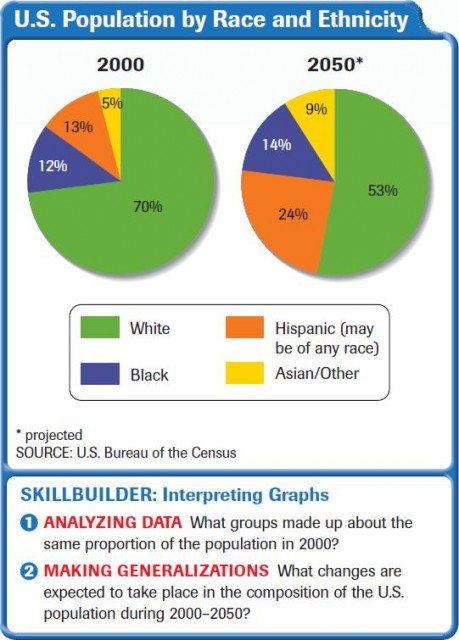CASE STUDY. Diverse Societies Face Change
As you read earlier in this unit, the first immigrants to North America are believed to have come from Asia.
They are thought to have crossed a land bridge that existed in what is now the Bering Strait thousands of years ago. Since that time, millions of people from countries all over the world have immigrated to the United States and Canada. They have come in search of a new life in a new homeland. The challenge for citizens and governments of both the United States and Canada is to make sure that these diverse peoples continue to remain unified.
“Mosaic” or “Melting Pot”
After centuries of immigration, the United States and Canada are culturally diverse. They contain large populations of the world's cultures.
Ethnic neighborhoods with populations of Asians, Eastern Europeans, and Latin Americans are found in most large cities of both countries. In New York City alone, immigrant schoolchildren speak more than 100 different languages. The arrival of so many peoples over the years left the United States and Canada with the difficult task of forming a unified society. Each country approached the task of unifying its many cultures differently.
CANADA'S CULTURAL “MOSAIC”
Canada's earliest settlers were its native peoples. Its first European settlers came, as you have learned, from two distinct cultural groups—French and English. All of these groups kept their separate identities as the nation developed. Also, Canada encouraged immigration from all over the world. It wanted to fill its vast lands and expand its workforce and its domestic markets. These immigrants also were encouraged to retain their cultural heritage.
As a result, many Canadians have strong ethnic ties. In fact, as you read in Chapter 7, the ethnic identity of French-speaking citizens in Quebec has been so strong that at times they have even considered separating themselves from the Canadian confederation.
The Canadian government has officially recognized the multicultural nature of Canada. In 1988, it enacted the Canadian Multiculturalism Act to protect and promote diversity. Many Canadians believe that this policy ensures equality for people of all origins and enriches their nation. But not all agree. Some Canadians feel that diversity has promoted difference at the expense of “Canadianness.”
AMERICA'S “MELTING POT”
For many years, people in the United States believed that assimilation was the key. It was thought to be the best way to build one nation from many different peoples.
Assimilation occurs when people from a minority culture assume the language, customs, and lifestyles of people from the dominant culture. Native Americans were an example. In the late 19th century, they were encouraged and even forced to learn English, adopt Western dress, and become Christians to assimilate into the dominant white culture.
People expected immigrants to assimilate, too. Those who did not could face prejudice because of their cultural differences. Immigrants soon learned that life would be easier if they adopted the ways of their new country—if they underwent “Americanization.” Most of these immigrants had come from Europe. Many wanted to assimilate. They wanted to adopt a common language and culture—to become Americans.
New Immigrants Challenge Old Ways
The immigrants who came to the United States in the late 20th century brought different attitudes. They came mainly from Latin America and Asia. They were culturally or racially unlike earlier immigrant groups, who had come mainly from Europe. These later immigrants were less willing to give up their traditions and beliefs in order to assimilate.

DIVIDED OPINION
Some Americans felt that the new immigrants did not understand what made the United States unique. According to this point of view, America's strength has come from blending its diverse cultures to create something new—an American. They also believed that encouraging different languages and customs would promote separation, not unity. In response, they wanted immigration limited and English made the official language.
Other Americans, including many educators, held different views. They thought that American society would benefit by stressing multiculturalism, as the Canadians do.
As you can see, bringing many cultures together is a continuing challenge both in the United States and in Canada. So, how can cultural diversity be preserved and national unity forged? The Case Study Project and primary sources that follow will help you explore this question.